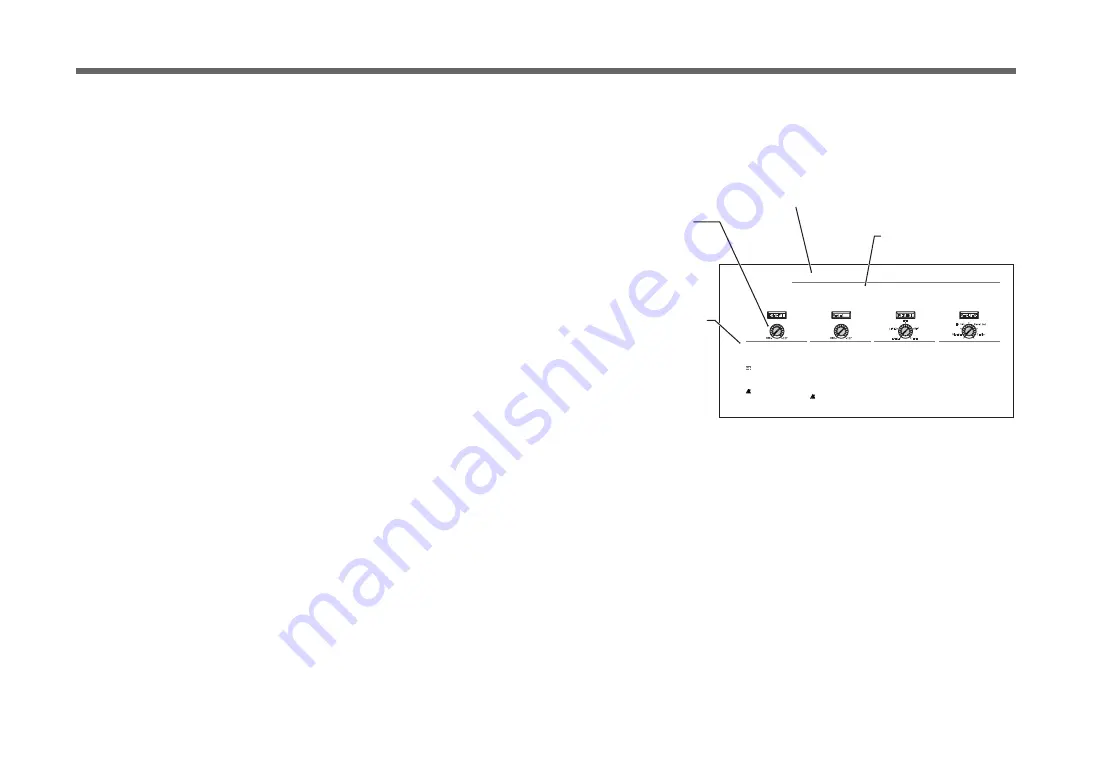
22
○ ○ ○ ○ ○ ○ ○ ○ ○ ○ ○ ○ ○ ○ ○ ○ ○ ○ ○ ○ ○ ○ ○ ○ ○ ○ ○ ○ ○ ○ ○ ○ ○ ○ ○ ○ ○ ○
Editing the arpeggiator
The
R3
’s arpeggiator provides six arpeggio types. In addition to selecting
an arpeggiator type, you can adjust the duration (gate time) , note value,
swing amount, tempo, and other arpeggiator parameters. These arpeg-
giator settings are adjusted using the 32. Arpeggiator-A page and 33.
Arpeggiator-B page parameters. Arpeggiator patterns can be up to eight
steps long, and each step can be individually switched on or off (play or
mute), providing more rhythmic versatility. (
☞
Refer to page 15 for more
information about arpeggiator steps.)
Selecting which timbre(s) will be played by the arpeggiator
In a synth program that uses two timbres, you can select which timbre(s)
will be played by the arpeggiator. This is specified by Arpeg-A page
“Assign” (knob [1]). You can arpeggiate both timbres, only timbre 1 or
only timbre 2.
Sync’ing the LFO rate and the delay time to the arpeggiator
By synchronizing the LFO 1/2 rate to the tempo of the arpeggio, you can
apply modulation that follows the arpeggiator tempo. You can also set
the time parameter of the delay effect to be a ratio of the tempo, so that
the delay time will remain appropriate even if you change the tempo of
the arpeggio. This is particularly convenient for live performances.
Because the
R3
’s arpeggiator can be synchronized to an external MIDI
sequencer, then in turn you can control the LFO 1/2 rate or the delay
time from an external MIDI sequencer. (
☞
p.67)
Basic editing
○ ○ ○ ○ ○ ○ ○ ○ ○ ○ ○ ○ ○ ○ ○ ○ ○ ○ ○ ○ ○ ○ ○ ○ ○ ○ ○ ○ ○ ○ ○ ○ ○ ○ ○ ○ ○ ○
How to read the pages for each section
Knob [2]
Reso1 (Filter1 Resonance)
[0...127]
Sets the resonance of the filter. This will
emphasize the overtones near the cutoff
frequency specified by “Cutoff1,” adding
a distinctive character to the sound. In-
creasing this value will increase the effect.
Since movement of the “Cutoff1” knob will
affect the overtones that are boosted by
resonance, it is best to adjust “Cutoff1” and
“Reso1” in conjunction with each other
(
☞
Figure 8-1).
Depending on the cutoff frequency or
the input audio, increasing this value
may cause distortion.
Knob [3]
Filt1Bal (Filter1 Balance)
[LPF24…LPF12…HPF…BPF…THRU]
Selects the filter type. Intermediate settings
will produce a response that is between the
two filter types.
LPF12 (–12dB/oct), LPF24 (–24dB/oct):
Low Pass Filter (
☞
p35 “LFP:”).
HPF (-12dB/oct):
High Pass Filter (
☞
p35
“HFP:”).
BPF (-12dB/oct):
Band Pass Filter (
☞
p35
“BFP:”).
THRU:
The sound will output directly,
without passing through the filter.
Knob [1]
Cutoff1 (Filter1 Cutoff)
[0...127]
Sets the cutoff frequency.
Increasing this value will raise the cutoff
frequency.
“Cutoff1” can be varied by time-vari-
ant change produced by EG1, by key-
board playing dynamics (velocity),
and by note location (keyboard track-
ing).
If the “Cutoff1” value is set too low,
the volume may be extremely low, or
you may hear no sound at all.
8. FILTER1-A
The filter section changes the tonal character of the oscillators by passing only the desired portion of the sound - either above (Low Pass),
below (High-Pass), or centered on (Band Pass) the cutoff frequency
.
The
R3
has two filters (filter 1 and filter 2), and you can change their
routing to create more complex filter sounds. The filter 1 parameters are set in the 8. FILTER1-A page and 9. FILTER1-B page.
Knob [4]
Routing1
[Single, Serial, Para, Indiv]
Specifies the routing (connection) between
filter 1 and filter 2.
Single:
Only filter 1 is used.
Serial:
Filter 1 and filter 2 are connected in
series (
☞
Figure 8-2).
Parallel:
Filter 1 and filter 2 are connected
in parallel (
☞
Figure 8-3).
Indiv:
Filter 1 is applied to oscillator 1, and
filter 2 is applied to oscillator 2 and noise
(
☞
Figure 8-4).
These are the edit control
knobs [1]–[4]. The markings
printed around each knob are
the values that will be selected
when you turn that knob.
These positions are
approximate.
This area lists the parameters
that are edited by edit control
knobs [1]–[4] when the above
section is selected. The range of
values for each parameter is
given in square brackets [ ].
Explanations of each parameter
and its values are given below.
This is the name of the section.
When you have set the [PAGE]
dial to the 8. Filter1-A page and
would like to see an explanation of
the parameters, refer to this page.
A summary of this section is
given here.
Summary of Contents for R3
Page 1: ...1 E ...
Page 2: ...ii ...








































